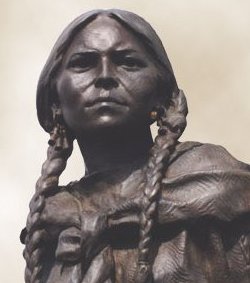French trapper, who kept her as a kind of wife.
The Lewis &
Clark expedition built Fort
Mandan to live in over the winter of 1804-05, on the east bank of the
Missouri river in what is now North Dakota. Here they hired Charbonneau
as a translator, who insisted on bringing Sacajawea. In 1804 Sacajawea
was sixteen years old, and pregnant. She gave birth at Fort Mandan in February
of 1805; the expedition left on April 7th, traveling over 3,000 miles to
the Pacific Ocean in 1805 and returning in 1806.
As
the expedition reached the western portion of Montana, Sacajawea began
to recognize the landmarks, since her tribe lived in these lands. The expedition
eventually met and stayed with her tribe, now headed by her brother, her
only surviving relative. The Lewis
& Clark Memorial, a life-sized bronze statue of Lewis, Clark, Sacajawea,
and her son Jean Baptiste, commemorates their trip in this region. This
statue, Montana’s official state memorial of the expedition, stands in
Fort Benton.
The
expedition traveled overland by canoe, on horseback, and by foot.
The expedition camped at the confluence of the Clearwater and Snake
rivers in 1805 and again on their way back in 1806, where today the city
of Lewiston, Idaho, stands, and a memorial to Sacajawea lies here. Sacajawea
State Park in Pasco, Washington, marks the spot at which the Lewis
& Clark expedition first saw the Columbia River, on the final leg of
their journey west. The park is dedicated to Sacajawea's role on the expedition,
and to the culture of the native people they encountered in this area.
Nearby Lake Sacajawea is also named for her. The expedition first sighted
the Pacific Ocean on November 15, 1805. |

